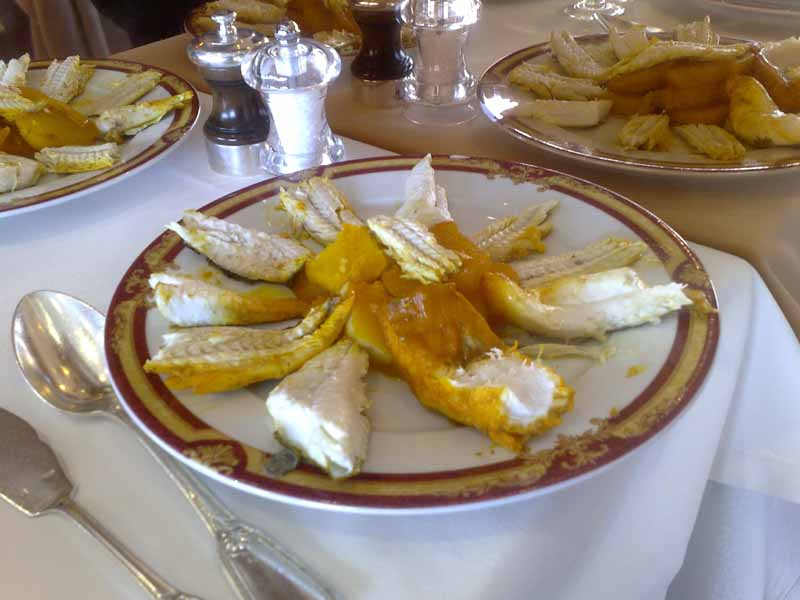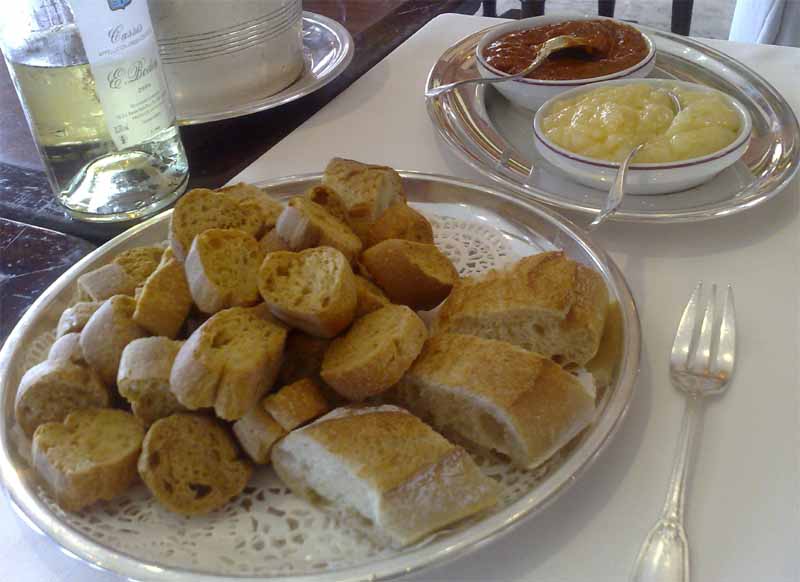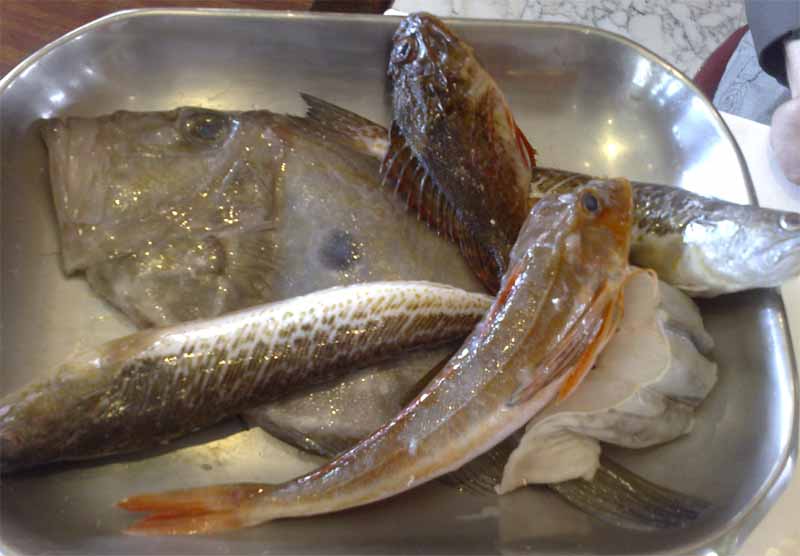Articles
01 June 2008
Bouillabaisse
"Savante émulsion de vingt poissons divers,
Plat inventé, dit-on, par Vénus elle-même
Pour plaire à Cupidon, dans un dessein pervers,
Elle fut pour les dieux une surprise extrême."
La Bouillabaisse
Rimes Gourmandes
Albert Couvreur, 1952
A legend tells that the goddess Venus prepared a Bouillabaisse to put her husband Vulcano to sleep and to flirt with Mars after. The most famous of all soups has, for some people, a divine origin. The certain thing is that, far from the Olympus, or probably, not so much, the golden soup (Soupe d'or, like Curnonsky, Prince of the Gastronomers, called it) was born together with the sea, next to the fishermen and their humble boats, on the coasts of the Provence.
It is a simple, economic dish, thought to be prepared by the beach once the fishing day was finished, with seawater and wood fire and with all the fish broken or those of worse commercial quality. Every coastal village has an own soup or stew made with fish: caldeirada, bourride, caldereta, abajá or sopa de pescado... In the Ancient Greece was prepared the kakavia, a soup of fish that might be the base of the Bouillabaisse, and that probably Phocaenans (Greeks of Asia Minor) brought with them when they founded Marseille about 600 A.C. . It is there where nowadays it reaches its maximum perfection.
Its reputation increased at the same time as the Côte d'Azur became fashionable among aristocrats and millionaires, as the English Lord Brougham, and it was broadcasted through the whole Europe. Like it usually happens with other dishes that have crossed over frontiers, there are so many Bouillabaisses as cooks, and its composition has become bourgeois from its modest origins.
It is said Bouillabaisse is better if it is prepared with a wide variety of fish: Rascasse (Scorpion fish), Chapon, Saint-Pierre (John dory), Congre (Conger eel), Vive (weever), Merlan du Palangre, Fiélas, Boudreuil, Rouquiers (Wrasse), Mostelle (Forkbeard), Rougets … in short, fresh rock fish, good olive oil, saffron … but also garlic, onion, potatoes, fennel, tomato, a bunch of fresh herbs,) orange zest, leek and pastís (the aniseed-flavoured appetizer of Provence), even Langoustes ou Langoustines. In 1980, the restaurateurs from Marseille signed a letter of purity, the "Charte de la Bouillabaisse", to protect and to defend the authentic recipe.
The technique that must be used to prepare it is explicit in its name: a great container where to boil "bouillir" and to reduce "abaissier" with strong fire. A rapid boiling produces an emulsion of the oil and the gelatine of the fish. The softest fish disintegrate during the boiling and enrich the broth, whereas the firmest, will be served whole. The result is an unctuous broth, with body and with an intense sea flavor aromatized with herbs.
The classic service consists of two parts, the wonderful soup in a pan on a stove, to eat with bread toasts (in Marseille they use marette, a rustic bread not to be toasted) and the sauce rouille and then the fish in the ideal point of boiling (that it is necessary to slice in front of the retainer) and the potatoes in a tray, which can be accompanied of garlic mayonaise and certainly of good wine from Var, the perfect pairing.
A seaworthy dish that A. Escoffier qualified as " Broth of the Sun ", undoubtedly, a delicious concentrate of Mediterranean aromas, the eternal classic we must not miss.
Dra. Laura Gosalbo
June 2008
.jpg)
The soup

Preparing the fish to serve with the soup

Fish with potatoes

Bread and sauces: allioli and rouille

The fish
> BackPlat inventé, dit-on, par Vénus elle-même
Pour plaire à Cupidon, dans un dessein pervers,
Elle fut pour les dieux une surprise extrême."
La Bouillabaisse
Rimes Gourmandes
Albert Couvreur, 1952
A legend tells that the goddess Venus prepared a Bouillabaisse to put her husband Vulcano to sleep and to flirt with Mars after. The most famous of all soups has, for some people, a divine origin. The certain thing is that, far from the Olympus, or probably, not so much, the golden soup (Soupe d'or, like Curnonsky, Prince of the Gastronomers, called it) was born together with the sea, next to the fishermen and their humble boats, on the coasts of the Provence.
It is a simple, economic dish, thought to be prepared by the beach once the fishing day was finished, with seawater and wood fire and with all the fish broken or those of worse commercial quality. Every coastal village has an own soup or stew made with fish: caldeirada, bourride, caldereta, abajá or sopa de pescado... In the Ancient Greece was prepared the kakavia, a soup of fish that might be the base of the Bouillabaisse, and that probably Phocaenans (Greeks of Asia Minor) brought with them when they founded Marseille about 600 A.C. . It is there where nowadays it reaches its maximum perfection.
Its reputation increased at the same time as the Côte d'Azur became fashionable among aristocrats and millionaires, as the English Lord Brougham, and it was broadcasted through the whole Europe. Like it usually happens with other dishes that have crossed over frontiers, there are so many Bouillabaisses as cooks, and its composition has become bourgeois from its modest origins.
It is said Bouillabaisse is better if it is prepared with a wide variety of fish: Rascasse (Scorpion fish), Chapon, Saint-Pierre (John dory), Congre (Conger eel), Vive (weever), Merlan du Palangre, Fiélas, Boudreuil, Rouquiers (Wrasse), Mostelle (Forkbeard), Rougets … in short, fresh rock fish, good olive oil, saffron … but also garlic, onion, potatoes, fennel, tomato, a bunch of fresh herbs,) orange zest, leek and pastís (the aniseed-flavoured appetizer of Provence), even Langoustes ou Langoustines. In 1980, the restaurateurs from Marseille signed a letter of purity, the "Charte de la Bouillabaisse", to protect and to defend the authentic recipe.
The technique that must be used to prepare it is explicit in its name: a great container where to boil "bouillir" and to reduce "abaissier" with strong fire. A rapid boiling produces an emulsion of the oil and the gelatine of the fish. The softest fish disintegrate during the boiling and enrich the broth, whereas the firmest, will be served whole. The result is an unctuous broth, with body and with an intense sea flavor aromatized with herbs.
The classic service consists of two parts, the wonderful soup in a pan on a stove, to eat with bread toasts (in Marseille they use marette, a rustic bread not to be toasted) and the sauce rouille and then the fish in the ideal point of boiling (that it is necessary to slice in front of the retainer) and the potatoes in a tray, which can be accompanied of garlic mayonaise and certainly of good wine from Var, the perfect pairing.
A seaworthy dish that A. Escoffier qualified as " Broth of the Sun ", undoubtedly, a delicious concentrate of Mediterranean aromas, the eternal classic we must not miss.
Dra. Laura Gosalbo
June 2008
.jpg)
The soup

Preparing the fish to serve with the soup

Fish with potatoes

Bread and sauces: allioli and rouille

The fish





